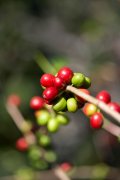Grading according to the proportion of sieve and defective beans

Grading according to the proportion of screen and defective beans
Defective beans are an important factor that destroys the flavor of the final coffee. Therefore, defective beans should also be removed in the last step of raw bean processing. Therefore, according to the proportion of defective beans, supplemented by the size of the screen is also used as a way of classification. Due to the rise of boutique coffee, coffee producing countries pay more and more attention to the quality of coffee, and the control of defective beans is the most important way, so basically using the proportion of defective beans as a grading method or auxiliary basis is becoming more and more common.
At present, the main representative countries that use defective bean proportion method are Jamaica, Brazil, Ethiopia and so on. Jamaica is based on the production area, altitude, screen, defective bean proportion comprehensive as the rating standard, defective bean proportion as an important basis. Jamaica strictly controls the proportion of defective beans, and the proportion of defective beans in all grades is no more than 4%.
Brazil is another special country. Brazil is the largest coffee producing country in the world. Because of its large output and many producing areas, the classification work is quite troublesome, and it is not suitable to adopt a single classification standard, so Brazil also uses a variety of classification methods at the same time. Defective bean proportion, sieve and cup evaluation tests are all used in the grading process of Brazilian coffee beans. Needless to say about the first two, the cup evaluation test is one of the characteristics of Brazilian coffee grading.
The so-called cup evaluation test is to evaluate the aroma and taste of raw coffee beans by soaking them in hot water (about 90 degrees) after baking. It is mainly divided into six grades: Strictly Soft extremely mild, Soft mild, Softish slightly mild, Hard difficult, Rio light iodine taste, Rioy strong iodine flavor. The first three grades can be called mild, with a balanced sweet and sour coffee and a mild taste. The latter three taste slightly worse, especially the latter two are the worst. The reason for the iodine smell is that the soil near Rio de Janeiro has a strong iodine smell, and the coffee is dropped on the ground during harvest and is contaminated with the peculiar smell of the adsorbed soil.
The above three are the popular coffee grading methods, but not all of them. For example, Ethiopia will take the handling of raw coffee beans as one of the grading criteria. In addition, there is a more and more widely used COE rating system. As coffee producing countries pay more and more attention to coffee quality and the enthusiasm of producers, the classification of raw coffee beans is not limited to the above three main ways. Only with more careful planting can we produce higher quality coffee and get a high rating in the grade evaluation, so the subdivision and strict control of coffee rating is undoubtedly a good thing for the improvement of coffee quality.
Important Notice :
前街咖啡 FrontStreet Coffee has moved to new addredd:
FrontStreet Coffee Address: 315,Donghua East Road,GuangZhou
Tel:020 38364473
- Prev

The way of sieve grading is to grade according to the size of raw coffee beans. The raw bean passes through the iron with holes.
The way of grading according to the screen is the method of grading according to the size of raw coffee beans. Raw beans are graded by determining the size of the beans through a holed iron plate sieve. The size of the hole in the screen is 1x64 inches (less than 0.4mm), so the size of the screen indicates that there are several screens with a size of 64 inches. For example, the size of the screen size 17 is 17thumb 64 inches, which is about 6.75mm, so the screen
- Next

Determination of the selection of grading methods in various countries
1. Generally speaking, coffee is not classified according to altitude in countries near the equator because coffee is grown at a higher altitude. In addition, if it is picked by hand and processed by washing, it will not be graded by bad points because there are few immature beans and sundries mixed in. Therefore, the size of the sieve number is generally used as the grading standard. Such as: Colombia, Tanzania, Kenny
Related
- Beginners will see the "Coffee pull flower" guide!
- What is the difference between ice blog purified milk and ordinary milk coffee?
- Why is the Philippines the largest producer of crops in Liberia?
- For coffee extraction, should the fine powder be retained?
- How does extracted espresso fill pressed powder? How much strength does it take to press the powder?
- How to make jasmine cold extract coffee? Is the jasmine + latte good?
- Will this little toy really make the coffee taste better? How does Lily Drip affect coffee extraction?
- Will the action of slapping the filter cup also affect coffee extraction?
- What's the difference between powder-to-water ratio and powder-to-liquid ratio?
- What is the Ethiopian local species? What does it have to do with Heirloom native species?

